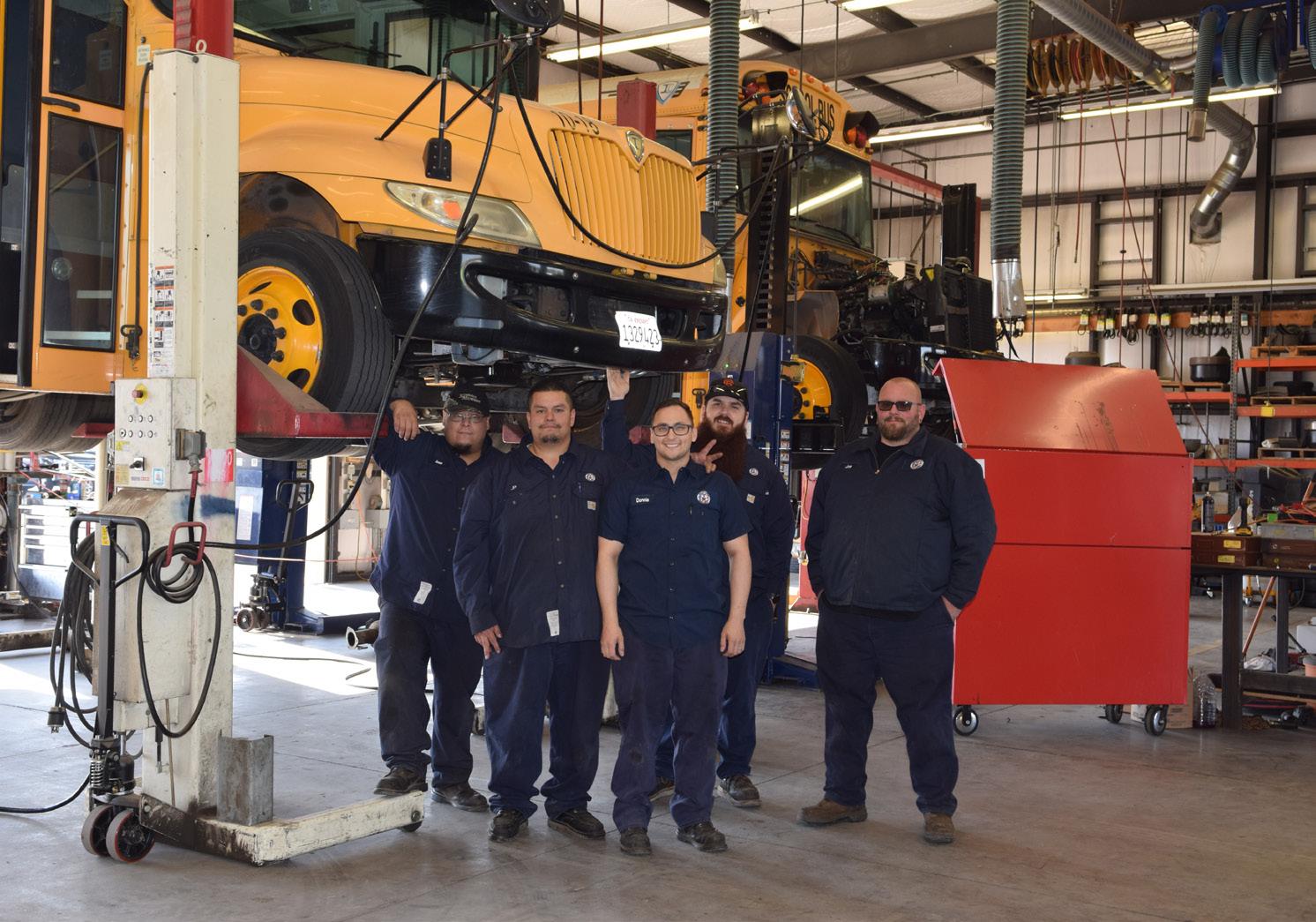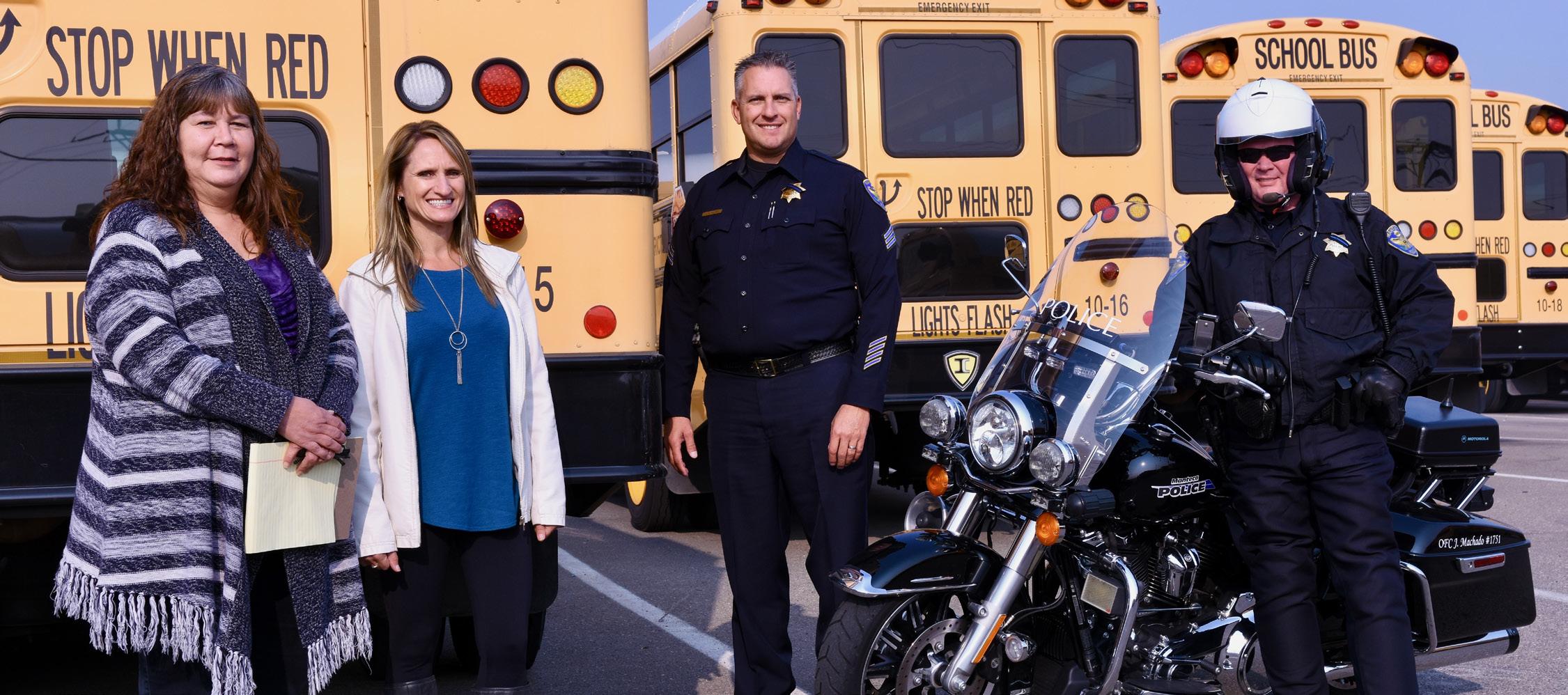
6 minute read
The Mark Highlights - November 2019
The month of October is recognized as School Bus Safety Month; and for a good reason. The school bus is the safest vehicle on the road by a landslide. It is 70x more likely for students to get to school safely when taking a school bus, instead of traveling by car. California ranks to have the best school bus driving record in the nation.
Melody Ford, Manteca Unified Director of Transportation, would argue that MUSD has the best school bus drivers throughout the state. “We only hire the most qualified and trained bus drivers,” she explained. “Even when we desperately need drivers, we will not settle. This is where mistakes happen in other districts.”
California school bus drivers are held to a very high standard and becoming a school bus driver is no easy task. A trainee must complete a minimum of 20 hours of required classroom training established by the CA Department of Education, pass a commercial driver’s license test (both written and behind the wheel), a medical physical exam, background and drug test clearance, interview with CHP, and obtain a first aid and CPR certification. Once hired, every 5 years they must repeat the process. One of the reasons the school bus is ranked the safest vehicle is because it is the most regulated vehicle.
Sherry Daugherty is a school bus driver having served Manteca Unified for nearly 30 years. “Student safety actually begins before we even pick up students,” Daugherty explained. “We come in a half-hour early to give our bus a full inspection.” Every school bus driver inspects their bus for working lights and tightened lug nuts, to fluids and complete air brake checks. If the school bus does not pass the daily inspection, it is deemed out of service and sent to the inhouse mechanic shop immediately. Drivers resort to a spare bus and begin the inspection process again before taking route.

Transportation Department Mechanics
The MUSD mechanic shop armed with trained and certificated school bus mechanics, maintenance district buses nearly every 30 days, with state law requiring every 45 days. The CHP performs audits every 13 months, reviewing maintenance logs of certified school busses and records of school bus drivers. “We have never had a school bus red-tagged,” shared Ford. “Our mechanics work very thoroughly and are just awesome.”
When a school bus passes the morning inspection, it is now ready to transport students to and from school. On average, the MUSD transportation team busses 1,895 students daily. This happens through 50 established bus routes, 69 buses among the fleet, and 56 school bus drivers with 2 state certified trainers, Deborah Rice and Amy Wahl.

Director of Transportation Melody Ford, and Supervisor Julie Fannin meet with Lt. Schluer and officer.
Before students board the school bus, they scan what is called a Z Pass. Each pass is student specific and allows Ford and her team to track if and when a student rides the bus, and when that student exits the bus. Coupled with the school bus’ internal GPS system, Ford is aware of the location of a bus and which students are aboard said bus, at all times. In addition, each bus has fisheye cameras for both student and driver protection.
Mark Hersman is also a Manteca Unified school bus driver who has served for 32 years. He explained that, a big part of school bus safety is teaching the students how to ride the bus, get on and off safely, and use caution around the bus. “Every year we practice school bus emergency evacuations with the students. But my students practice throughout the year, all the time.” Part of the emergency evacuation routine is learning how to exit through the emergency exits which include the windows, and the side and back door. Hersman shared that familiarizing the students with the safety tools and equipment is not only important, but arms them with a sense of preparedness.
“When we arrive to school with a few minutes to spare, the students consistently volunteer to practice the evacuations. They get a kick out of opening the windows! I also have two little bus helpers (students), who help ensure that each student is buckled up before takeoff.
“Kids can be unpredictable, so it is important to teach them the safest way to ride and approach the bus, and to reiterate those messages from day to day.” It is illegal for adults to board the school bus with the exception of the driver, CHP, and trainers. If it is a field trip, then teachers, parents and chaperones are permitted. Ford, Daugherty, and Hersman explained that sometimes parents try to help their child onto the bus, and this is not lawful with the consideration of the safety of other students onboard.

When a school bus driver is completed with their route, there is safety feature that is connected to the ignition and bus doors. Before a school bus driver can exit the bus, an alarm is signaled which requires the driver to walk to the end of the bus, within 3 minutes, to disable the alarm. If the alarm sounds, flashing red lights and horns react with a non-stop siren that can be heard from a great distance.
“We have implemented the bus alarm for a couple years now, but it became a state law just this year,” shared Ford. “The alarm is in place to force the driver to walk to the end of the bus, checking seats for students who may still be onboard.”
A school bus driver is the first person a student sees in the morning that is connected to school, and is the last person to see them off at the end of the day. While some students are only on the bus for 10 minutes, other students ride the bus for nearly an hour each day.

From left: Director of Transportation Melody Ford, Bus Driver Mark Hersman, Bus Driver Sherry Daugherty
“You develop a relationship with them and become part of their lives,” Hersman reflected. “I’ve been on this same route for 20 years and have witnessed these students and families grow up.” Daugherty shared that they’re not just bus drivers. They are parents, referees, confidants, babysitters, and psychologists at times.
However, a bus driver is always a mandated reporter. “I’ve had drivers come to me with concerns and we have identified homeless students, or students who suffer from issues within the home. We were able to inform the appropriate people, who provided students and families with resources,” Ford stated.
Hersman and Daugherty are MUSD’s two top seniority drivers. When asked what has kept them in their role for 30 years, their responses were centered, wholeheartedly, for the care of students. Hersman expressed, “I never thought that I would do this job for my whole working life, but it keeps calling me back. There have been other opportunities through the years, but I love the kids. That part of the job is so enjoyable.”
Daugherty shared, “It is my therapy and I would do it for free. I look forward to coming to work; I cannot wait to get here, and everybody knows it. I love kids and I love driving. Everything about it is perfect. Even over summers, I count the days to come back.”

The MUSD Transportation Department



